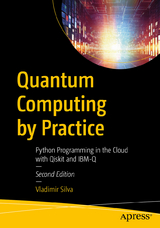
Practical Quantum Computing for Developers
Apress (Verlag)
978-1-4842-4217-9 (ISBN)
- Titel erscheint in neuer Auflage
- Artikel merken
Furthermore, this book shows you how to do quantum programming using the QISKit (Quantum Information Software Kit), Python SDK, and other APIs such as QASM (Quantum Assembly). You’ll learn to write code using these languages and execute it against simulators (local or remote) or a real quantum computer provided by IBM’s Q Experience. Finally, you’ll learn the current quantum algorithms for entanglement, random number generation, linear search, integer factorization, and others. You’ll peak inside the inner workings of the Bell states for entanglement, Grover’s algorithm for linear search, Shor’s algorithm for integer factorization, and other algorithms in the fields of optimization, and more.
Along the way you’ll also cover game theory with the Magic Square, an example of quantum pseudo-telepathy where parties sharing entangled states can be observed to have some kind of communication between them. In this game Alice and Bob play against a referee. Quantum mechanics allows Alice and Bob to always win!
By the end of this book, you will understand how this emerging technology provides massive parallelism and significant computational speedups over classical computers, and will be prepared to program quantum computers which are expected to replace traditional computers in the data center.
What You Will Learn
Use the Q Experience Composer, the first-of-its-kind web console to create visual programs/experiments and submit them to a quantum simulator or real device on the cloud
Run programs remotely using the Q Experience REST API
Write algorithms that provide superior performance over their classical counterparts
Build a Node.js REST client for authenticating, listing remote devices, querying information about quantum processors, and listing or running experiments remotely in the cloud
Create a quantum number generator: The quintessential coin flip with a quantum twist
Discover quantum teleportation: This algorithm demonstrates how the exact state of a qubit (quantum information) can be transmitted from one location to another, with the help of classical communication and quantum entanglement between the sender and receiver
Peek into single qubit operations with the classic game of Battleships with a quantum twist
Handle the counterfeit coin problem: a classic puzzle that consists of finding a counterfeit coin in a beam balance among eight coins in only two turns
Who This Book Is For
Developers and programmers interested in this new field of computing.
Vladimir Silva participates in the IBM WebAhead technology think tank, and is a recognized expert in grid computing, neural nets, and artificial intelligence. He holds numerous IT certifications including OCP, MCSD, and MCP, and has written many technical articles for IBM developerWorks. His previous books include: Grid Computing for Developers (Charles River Media), Practical Eclipse Rich Client Platform (Apress), Pro Android Games (Apress), and Advanced Android 4 Games (Apress).
Chapter 1: The Bizarre World of Quantum MechanicsQuantum Realm to Einstein and Newton: We don’t need no stinky classical physicsWeird Things happen at Tiny ScalesEntanglement: Spooky Action at a DistanceSuperposition of StatesArchitecture of a Quantum ComputerFundamental Properties of a Quantum ComputerSuperpositionInterference, DecoherenceWhat is a Qubit?Single GatesBit Flip: The X GateHadamard Gate (H)Superposition Phase Change: Z, S, T Gates. Muti-GatesConditional gate (CNOT)Massive Parallelism with EntanglementBell and GHZ StatesNon-Clifford GatesVisualize the Qubit with the Bloch SpherePrograming LingoExited States and Pauli OperatorsDirac NotationSuperposition and DecoherenceChapter 2: Welcome to Big Blue’s Quantum Rig: The IBM QExperienceGetting your feet wet with IBM’s QExperienceHistograms: Basic Qubit representationsQuantum Composer and ScoresBasic Quantum CircuitsExperiment EditorProgramming Languages: QASM vs PythonChapter 3: Start your Engines – Basic AlgorithmsComplex Quantum Circuits and Unitary TransformationsFourier TransformChapter 4: Exponential Speedups with the Deutsch-Jozsa AlgorithmMotivationClassical SolutionChapter 5: Unstructured Search: Grover’s AlgorithmMotivationAlgorithm stepsQuantum oracleGeometric proofAlgebraic proofExtension with multiple targetsChapter 6: Factorization with Shor’s algorithmSimon's algorithmInspiration for Shor's algorithmComplexityFactorization ProblemShor vs Number Field Sieve: Polynomial vs Exponential SpeedupsPeriod of the Modular ExponentChapter 7: Public Experiments and PlaygroundTypes of QubitsOther Players – The Race is onWhat’s Next
| Erscheinungsdatum | 07.01.2019 |
|---|---|
| Zusatzinfo | 45 Illustrations, color; 98 Illustrations, black and white; XVII, 346 p. 143 illus., 45 illus. in color. |
| Verlagsort | Berkley |
| Sprache | englisch |
| Maße | 178 x 254 mm |
| Gewicht | 692 g |
| Themenwelt | Mathematik / Informatik ► Informatik ► Programmiersprachen / -werkzeuge |
| Informatik ► Theorie / Studium ► Compilerbau | |
| Informatik ► Theorie / Studium ► Künstliche Intelligenz / Robotik | |
| Mathematik / Informatik ► Mathematik ► Angewandte Mathematik | |
| Schlagworte | AI • algorithms • Artificial Intelligence • Assembly • Big Data • Cloud • Code • Cognitive • deep learn • Developers • Development • IBM • Program • Python • QExperience • quantum assembly • Quantum Computing |
| ISBN-10 | 1-4842-4217-3 / 1484242173 |
| ISBN-13 | 978-1-4842-4217-9 / 9781484242179 |
| Zustand | Neuware |
| Haben Sie eine Frage zum Produkt? |
aus dem Bereich



